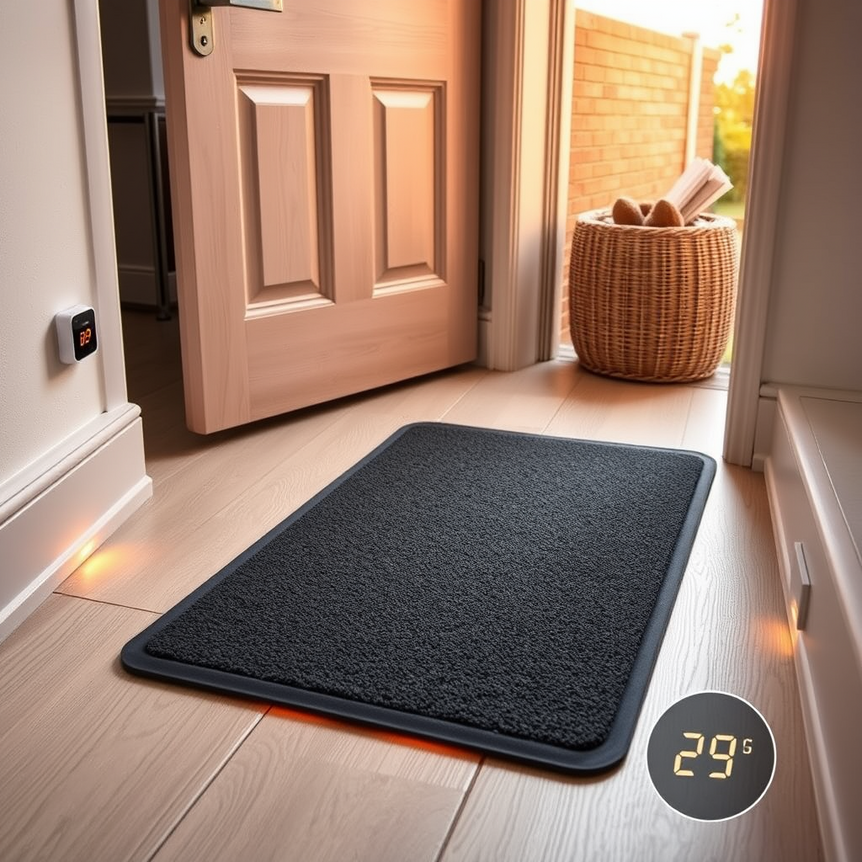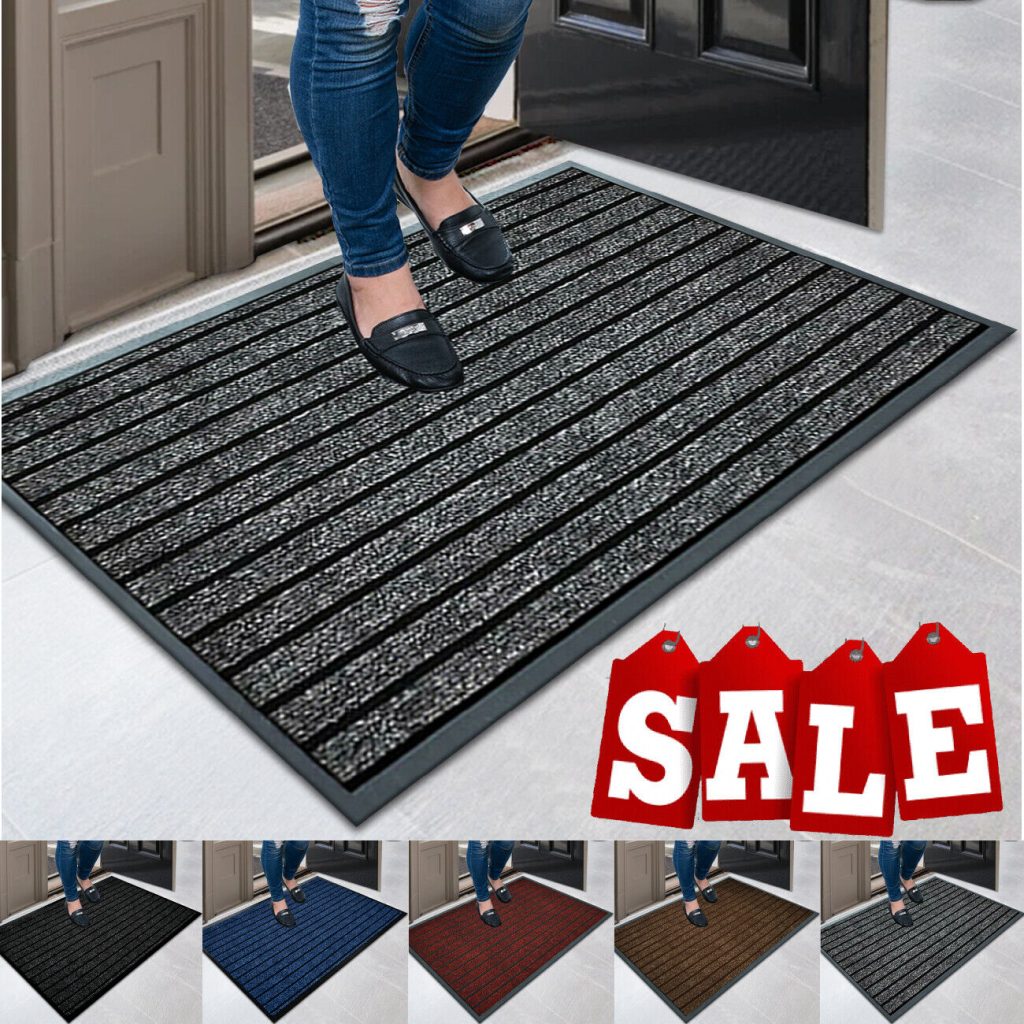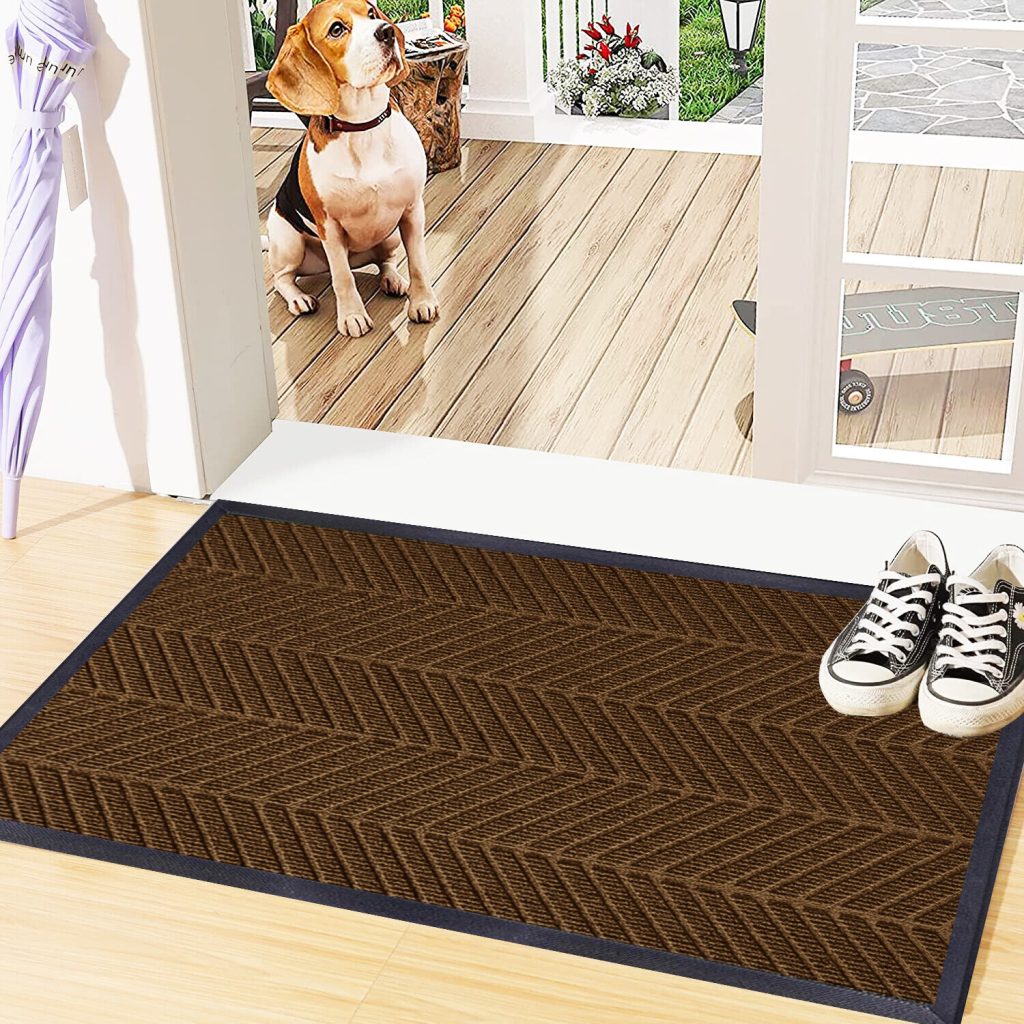Rubber-backed door mats are a popular choice for home entryways across the UK, cherished for their robust durability, excellent slip resistance, and ability to trap dirt and moisture. However, if your home features a modern underfloor heating system, the seemingly simple act of choosing a door mat becomes a crucial decision. The wrong mat can impact not only the efficiency of your heating but potentially damage your flooring and even the heating components themselves. This comprehensive guide delves into the compatibility of rubber-backed door mats with underfloor heating, providing you with essential insights and practical advice for safe and effective use.
How Underfloor Heating Systems Work and Why Flooring Choice Matters
Underfloor heating (UFH) systems are designed to warm your home efficiently and evenly through a network of electric cables or hot water pipes installed beneath the floor surface. Unlike traditional radiators, UFH provides radiant heat, which rises consistently across the room, offering a comfortable, invisible warmth. This method is highly energy-efficient when paired with the right flooring, as it leverages the entire floor area as a low-temperature radiator.
The effectiveness of any underfloor heating system hinges significantly on the thermal conductivity of the floor covering. Materials with high thermal conductivity, such as ceramic tiles, natural stone, or certain types of engineered wood, allow heat to pass through easily, ensuring efficient heat transfer to the room. Conversely, materials that act as thermal insulators – like thick carpets, some types of laminate, or dense mats – can impede heat flow. This heat retention beneath the floor covering forces the heating system to work harder, leading to reduced energy efficiency, increased energy bills, and a potential risk of localized overheating that could damage both the flooring and the heating elements themselves. Therefore, understanding the thermal properties of any floor covering, including your door mat, is paramount.
Characteristics of Rubber-Backed Door Mats Relevant to Heating Systems
Rubber-backed door mats, known for their practical benefits, typically consist of a hard-wearing fibrous surface bonded to a dense layer of rubber or synthetic rubber on the underside. This rubber layer offers:
- Exceptional Non-Slip Properties: The high friction of the rubber keeps the mat firmly in place, preventing slips and trips, especially on smooth floor surfaces like tiles or wood.
- Superior Water Resistance: The rubber layer creates a barrier, protecting the underlying floor from tracked-in moisture, dirt, and spills, which is invaluable in high-traffic entryways.
- Density and Thickness: While varying by design, the rubber backing often contributes significant thickness and density to the mat, impacting its overall thermal properties.
However, it’s precisely these characteristics that can pose challenges with underfloor heating. Rubber, particularly synthetic rubber compounds, is inherently a poor conductor of heat. This means that a thick rubber backing acts as a significant thermal barrier, effectively trapping heat beneath the mat. This heat retention can drastically reduce the effectiveness of your underfloor heating system, leading to uncomfortable cold spots on the mat’s surface and potentially causing the UFH system to overcompensate. Furthermore, prolonged exposure to sustained high temperatures can cause synthetic rubber materials to degrade, warp, become brittle, or even emit unpleasant odours, compromising both the mat’s integrity and indoor air quality.
Potential Risks of Using Rubber-Backed Mats on Underfloor Heating
While rubber-backed door mats offer excellent practical advantages, their interaction with underfloor heating systems presents several significant risks that homeowners should be aware of:
- Heat Insulation and Reduced Efficiency: The primary concern is the rubber backing’s insulating effect. It creates a thermal barrier that restricts the efficient transfer of heat from the UFH system into the room. This leads to uneven warmth, with noticeable cold spots on the mat’s surface, and forces the heating system to work harder to achieve the desired room temperature. This increased workload directly translates into higher energy consumption and, consequently, higher energy bills.
- System Overheating and Accelerated Wear: By trapping heat, the mat can cause localized overheating directly beneath its surface. While the mat itself won’t directly damage the UFH pipes or cables, the heating elements in that specific area will experience elevated temperatures. This continuous stress can accelerate the wear and tear of the heating components, potentially shortening their lifespan and leading to costly repairs or even premature system failure.
- Material Degradation and Off-Gassing: Prolonged exposure to elevated temperatures can cause the rubber backing to degrade. This degradation can manifest as melting, warping, cracking, or becoming brittle. In some cases, synthetic rubber materials may also ‘off-gas’ volatile organic compounds (VOCs) when heated, emitting unpleasant chemical odours that can compromise indoor air quality, especially in enclosed spaces like entryways.
- Flooring Damage and Warranty Implications: Trapped heat and, in some cases, moisture (if the mat is placed on a damp floor or if condensation occurs due to temperature differences) can severely damage certain types of flooring materials. Wooden floors, including solid wood, engineered wood, and even some laminates, are particularly susceptible to warping, cupping, or discolouration when exposed to prolonged, localized heat or moisture build-up. Vinyl and linoleum can also suffer from discolouration or softening. Furthermore, using an incompatible mat could potentially void the warranty on your flooring or underfloor heating system, making it a critical consideration.
Given these potential concerns, it is crucial to carefully assess the specific type of underfloor heating system you have, the material of your flooring, and the characteristics of any mat you intend to place on heated floors.
Comparing Rubber-Backed Mats with Alternative Mat Types for Heated Floors
For homes with underfloor heating, mats without thick, dense insulating backings are generally safer and more efficient. Here’s a comparison of common mat types:
| Mat Type | Heat Transfer | Pros | Cons |
|---|---|---|---|
| Rubber-Backed Mats | Low | Excellent slip-resistance, highly durable, waterproof barrier, effective dirt trapping. | Significant heat insulation, risk of material degradation, potential for flooring damage, can increase energy consumption. |
| Felt or Fabric Backed Mats | Medium | Better heat conductivity than thick rubber, softer surface, often machine washable. | May retain moisture, less slip-resistant than rubber, can compress over time reducing effectiveness. |
| PVC or Vinyl Backed Mats | Medium-Low | Often feature thinner backings, good water resistance, durable. | Can still inhibit heat slightly, some PVCs may become brittle or discolour with prolonged heat exposure. |
| Natural Fiber Mats (e.g., Coir, Jute, Cotton) | High | Highly breathable, excellent heat transfer, often eco-friendly, can be very absorbent. | Less durable than synthetic options, may shed fibres, less slip-resistant (often require a separate underlay), can be susceptible to moisture damage. |
| Gel-Backed or Open-Mesh Backed Mats | Medium-High | Designed for better heat dissipation, offer some non-slip properties, typically thinner. | May not be as robust as solid rubber, range of durability varies greatly by product. |
When making your selection, prioritise mats with thinner, more breathable backings and those made from materials that facilitate heat transfer. Opting for natural fibres or specially designed low-thermal-resistance synthetic backings will significantly reduce insulation effects and help protect the efficiency and longevity of your underfloor heating system.
Tips for Safely Using Door Mats on Underfloor Heating Systems
If you have underfloor heating, but still desire the practicality and aesthetic appeal of a door mat, follow these best practices to ensure both safety and efficiency:
- Prioritise Thin and Breathable Backings:The golden rule is to choose mats with the thinnest possible backings. Look for options with an open-weave or mesh backing, or those with a very thin, flexible PVC or felt layer rather than solid, dense rubber. These materials allow for greater airflow and better heat dissipation. When selecting a durable, slip-resistant mat that offers protection without excessive thickness, consider the range of high-quality rubber backed doormats available at Rugstars. Always verify product specifications for their suitability with heated floors.
- Monitor Mat Thickness:As a general guideline, many underfloor heating manufacturers recommend that any floor covering (including mats) should not exceed a certain thermal resistance value. For mats, this often translates to a maximum thickness of around 6mm. Thinner mats ensure optimal heat conductivity and prevent significant heat build-up.
- Allow for Air Circulation:Avoid placing mats permanently in one spot, especially if they are thick or have dense backings. Periodically lift and air out the mat and the floor beneath it. This allows any trapped heat or moisture to dissipate and prevents localized hot spots. Consider rotating the mat’s position if possible.
- Strategic Placement in Cooler Zones:If feasible, place your door mat in areas where the underfloor heating is either off, set to a lower temperature, or where heat transfer is less critical. Entryways often serve as buffer zones, and if your UFH system allows for zoning, you might designate this area as a lower temperature zone.
- Adhere to Manufacturer Guidelines:Always consult the manual for your specific underfloor heating system. Manufacturers often provide clear guidelines on compatible floor coverings, maximum allowable thermal resistance, and any restrictions on placing rugs or mats. Adhering to these guidelines is crucial for maintaining your system’s warranty and ensuring its longevity.
- Seek Professional Advice:If you are unsure about the compatibility of a specific mat with your underfloor heating system or have concerns about your flooring type, don’t hesitate to consult a flooring specialist or an underfloor heating professional. They can offer tailored advice and help you make an informed decision.
Maintenance and Care to Preserve Both Mats and Heating Efficiency
Proper maintenance is key to extending the lifespan of both your door mats and ensuring the optimal performance and longevity of your underfloor heating system.
- Regular Cleaning:Clean your mats regularly according to their specific care instructions. Accumulated dirt, dust, and debris within the mat’s fibres can act as an additional insulating layer, further impeding heat transfer. Regular vacuuming and occasional deeper cleaning will ensure the mat remains effective at trapping dirt without becoming a thermal barrier.
- Thorough Drying:Ensure that both the mat and the floor surface beneath it are completely dry, especially after cleaning or if they have become wet from tracked-in moisture. Moisture trapped between the mat and a heated floor can create a humid environment, potentially leading to mildew growth, unpleasant odours, or even damage to the flooring material over time.
- Periodic Inspection and Replacement:Regularly inspect your rubber-backed mats for any signs of heat damage. Look for warping, cracking, brittleness, discolouration, or softening of the rubber backing. If you notice any of these signs, it’s a clear indication that the mat is not coping well with the heat, and it should be replaced immediately with a more suitable option to prevent further risks.
- Temperature Management:Utilise your underfloor heating system’s thermostats and timers effectively. Avoid setting excessively high temperatures in areas where mats are placed, and consider reducing the temperature or turning the heating off in these zones when not needed. Modern smart thermostats can help manage zones efficiently, reducing the risk of continuous high heat exposure under mats.
- Inspect Underlying Flooring:Periodically lift your mats and visually inspect the flooring beneath them for any signs of damage, such as discolouration, warping, cracking, or moisture stress. Early detection of any issues can prevent more extensive and costly damage to your floor.
By diligently following these maintenance steps, you can help preserve optimal heat flow, protect your valuable flooring, and extend the lifespan of both your door mats and your underfloor heating system.
Frequently Asked Questions About Rubber-Backed Door Mats and Underfloor Heating
Q: Can I use a rubber-backed door mat on electric underfloor heating?
A: While possible, it’s generally not recommended for prolonged use. Rubber’s insulating properties can trap heat, potentially reducing the efficiency of your electric underfloor heating and causing localised overheating. For optimal performance and safety, thinner-backed mats or those specifically designed for heated floors are preferred.
Q: Will a rubber-backed mat damage my underfloor heating system?
A: The mat itself typically won’t directly damage the UFH system’s components. However, the restricted heat flow caused by the rubber backing can make the heating elements work harder, leading to increased energy consumption and potentially shortening the lifespan of your heating system due to consistent thermal stress.
Q: How thick can my door mat be if I have underfloor heating?
A: Manufacturer recommendations vary, but a common guideline suggests mats no thicker than 6mm to ensure good heat conductivity and prevent excessive insulation. Always check your specific underfloor heating system’s manual for precise recommendations.
Q: Are there rubber-backed mats made specifically for underfloor heating?
A: Yes, some manufacturers produce rubber-backed mats that are specifically tested and certified for compatibility with underfloor heating systems. These usually feature thinner or more breathable rubber compounds. Always verify product specifications and certifications before purchasing.
Q: What types of mats are safest for underfloor heating?
A: Mats with breathable, open-weave backings, or those made from natural fibres like jute or coir, are generally the safest for underfloor heating as they allow heat to dissipate effectively. Thinner felt or gel-backed options can also be suitable, provided they are designed for use with heated floors.
By carefully selecting and maintaining your door mats, you can enjoy the practical benefits of durable entryway protection without compromising the efficiency, longevity, or safety of your underfloor heating system. For optimal performance, thin, breathable mats with low thermal resistance remain the safest and most recommended choice.



